Fate of Fertilizer-Derived N Applied to Enhance Rice Straw Decomposition in a Paddy Field during the Fallow Season under Cool Temperature Conditions
Abstract
:1. Introduction
2. Materials and Methods
2.1. Experimental Setup and Cultivation
2.2. Investigation of the Growth of Rice Plants
2.3. Sample Collection and Analysis
2.4. Calculation of the Fertilizer-Derived N Distribution
2.5. Analysis of Labile Soil N Derived from Fertilizer
= Total soil N derived from fertilizer (g N m−2)
− Labile soil N derived from fertilizer (g N m−2)
2.6. Statistical Analysis
3. Results
3.1. Rice Straw Decomposition during the Fallow Sseason
3.2. Dynamics of Fertilizer-Derived N during the Fallow Season
3.3. Effect on the Growth and N Uptake of Rice Plants
3.4. Dynamics of Fertilizer-Derived N during Rice Growing Season
4. Discussion
4.1. Rice Straw Decomposition
4.2. Dynamics of Fertilizer N and its Effect on Plant Growth
4.3. Further Implications
5. Conclusions
Supplementary Materials
Acknowledgments
Author Contributions
Conflicts of Interest
References
- Chiba, M.; Shimazu, R.; Muto, K.; Uchida, S. Stable yield of the paddy rice by rice straw plowing. Bull. Iwate Agric. Exp. Stn. 1980, 22, 81–117. (In Japanese) [Google Scholar]
- Kubota, M. Reasonable application of rice straw to wet and semiwet paddy fields with heavy clay soil in Niigata. J. Niigata Agric. Exp. Stn. 1992, 39, 1–87. (In Japanese) [Google Scholar]
- Japan Lime Nitrogen Industries Association. Technical Information Q&A. 2012. Available online: http://www.cacn.jp/technology/qa.html (accessed on 29 March 2018). (In Japanese).
- Owa, N.; Hiradate, S.; Fujii, Y. Analysis of inhibition effect of nitrification by cyanamide, the main component of lime nitrogen (Sekkaichisso no shuseibun shianamido no shousankaseiyokuseisayou no kaiseki). Soil Microorg. 2010, 64, 137. (In Japanese) [Google Scholar]
- Kaneta, Y.; Goto, S.; Sato, T.; Takakai, F.; Yasuda, K.; Nosaka, T.; Sakashita, Y.; Urano, Y.; Ohyama, T. Effect of deep placement of calcium cyanamide on winter wheat in a heavy clay upland field formerly used to grow paddy rice. Jpn. J. Soil Sci. Plant Nutr. 2014, 85, 446–452. (In Japanese) [Google Scholar]
- Yamamoto, A.; Akiyama, H.; Naokawa, T.; Yagi, K. Effect of lime-nitrogen application on N2O emission from an Andosol vegetable field. Soil Sci. Plant Nutr. 2012, 58, 245–254. [Google Scholar] [CrossRef]
- Hirono, Y.; Nonaka, K. Effects of application of lime nitrogen and dicyandiamide on nitrous oxide emissions from green tea fields. Soil Sci. Plant Nutr. 2014, 60, 276–285. [Google Scholar] [CrossRef]
- Yamamoto, A.; Akiyama, H.; Naokawa, T.; Yagi, K. Lime-nitrogen application reduces N2O emission from a vegetable field with imperfectly-drained sandy clay-loam soil. Soil Sci. Plant Nutr. 2013, 59, 442–449. [Google Scholar] [CrossRef]
- Yamamoto, A.; Akiyama, H.; Naokawa, T.; Miyazaki, Y.; Honda, Y.; Sano, Y.; Nakajima, Y.; Yagi, K. Lime-nitrogen application affects nitrification, denitrification, and N2O emission in an acidic tea soil. Biol. Fertil. Soils 2014, 50, 53–62. [Google Scholar] [CrossRef]
- Takahashi, H.; Kato, M.; Kitazawa, A.; Shiojima, M.; Aasano, I.; Saito, M. Effects of continuous application of plown-in rice straw and incinerated rice straw to fine-textured strong gley soils on rice yield and paddy soil. Bull. Miyagi Prefect. Furukawa Agric. Exp. Stn. 2010, 8, 23–34. (In Japanese) [Google Scholar]
- Nishida, M.; Sumida, H.; Kato, N. Fate of nitrogen derived from 15N-labeled cattle manure compost applied to a paddy field in the cool climate region of Japan. Soil Sci. Plant Nutr. 2008, 54, 459–466. [Google Scholar] [CrossRef]
- Cultivated Soil Classification Committee. Classification of cultivated soils in Japan: Third approximation. Misc. Publ. Natl. Inst. Agro-Environ. Sci. 1995, 17, 1–79. (In Japanese) [Google Scholar]
- Food and Agriculture Organization of the United Nations (FAO). World Reference Base for Soil Resources; FAO: Rome, Italy, 2006. [Google Scholar]
- Ogawa, Y.V. 10 Available nitrogen. In Methods for Soil Environment Analysis; Konno, T., Ed.; Hakuyusha: Tokyo, Japan, 1997; pp. 255–262. (In Japanese) [Google Scholar]
- Yoneyama, T.; Arima, Y.; Kumazawa, K. Sample preparation from dilute ammonium Solution for emission spectrographic analysis of heavy nitrogen. Jpn. J. Soil Sci. Plant Nutr. 1975, 46, 146–147. (In Japanese) [Google Scholar]
- Goto, E.; Miyamori, Y.; Hasegawa, S.; Inatsu, O. Reduction effects of accelerating rice straw decomposition and water management on methane emission from paddy fields in a cold distinct. Jpn. J. Soil Sci. Plant Nutr. 2004, 75, 191–201. (In Japanese) [Google Scholar]
- Saigusa, M.; Hanaki, M.; Ito, T. Decomposition pattern of rice straw in poorly drained paddy soil and recovery rate of straw nitrogen by rice plant in no-tillage transplanting cultivation. Jpn. J. Soil Sci. Plant Nutr. 1999, 70, 157–163. (In Japanese) [Google Scholar]
- Ohsumi, A.; Heinai, H.; Matsumura, O. Yield and appearance quality of rice cultivated with basal dressing with lime nitrogen on clayey gley soil. Jpn. J. Crop Sci. 2013, 82, 28–33. (In Japanese) [Google Scholar] [CrossRef]
- Ministry of Agriculture. Forestry and Fisheries. 2017. Available online: http://www.e-stat.go.jp/SG1/estat/Pdfdl.do?sinfid=000031591756 (accessed on 29 March 2018). (In Japanese).
- Kobayashi, A.; Suzuki, Y.; Saiten, H.; Morooka, M.; Ishida, H. Effects of early release of ponding water on growth and yield of wetland rice under heavy application if rice straw in clayey gley paddy soil. Bull. Hokuriku Agric. Exp. Stn. 2000, 43, 25–45. (In Japanese) [Google Scholar]
- Naser, H.M.; Nagata, O.; Tamura, S.; Hatano, R. Methane emissions from five paddy fields with different amounts of rice straw application in central Hokkaido, Japan. Soil Sci. Plant Nutr. 2007, 53, 95–101. [Google Scholar] [CrossRef]
- Watanabe, A.; Satoh, Y.; Kimura, M. Estimation of the increase in CH4 emission from paddy soils by rice straw application. Plant Soil 1995, 173, 225–231. [Google Scholar] [CrossRef]
- Miura, Y. Rice straw management for mitigation of methane emission from paddy field. Spec. Bull. Fukushima Prefect. Agric. Exp. Stn. 2003, 7, 1–38. (In Japanese) [Google Scholar]
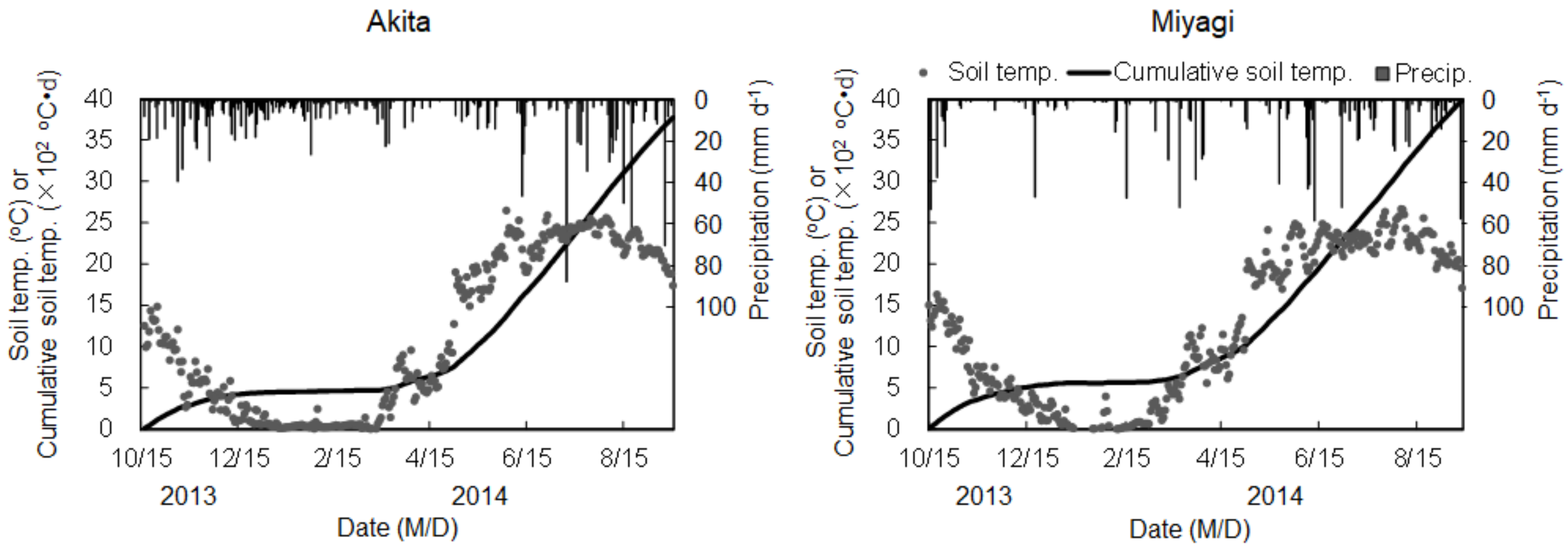
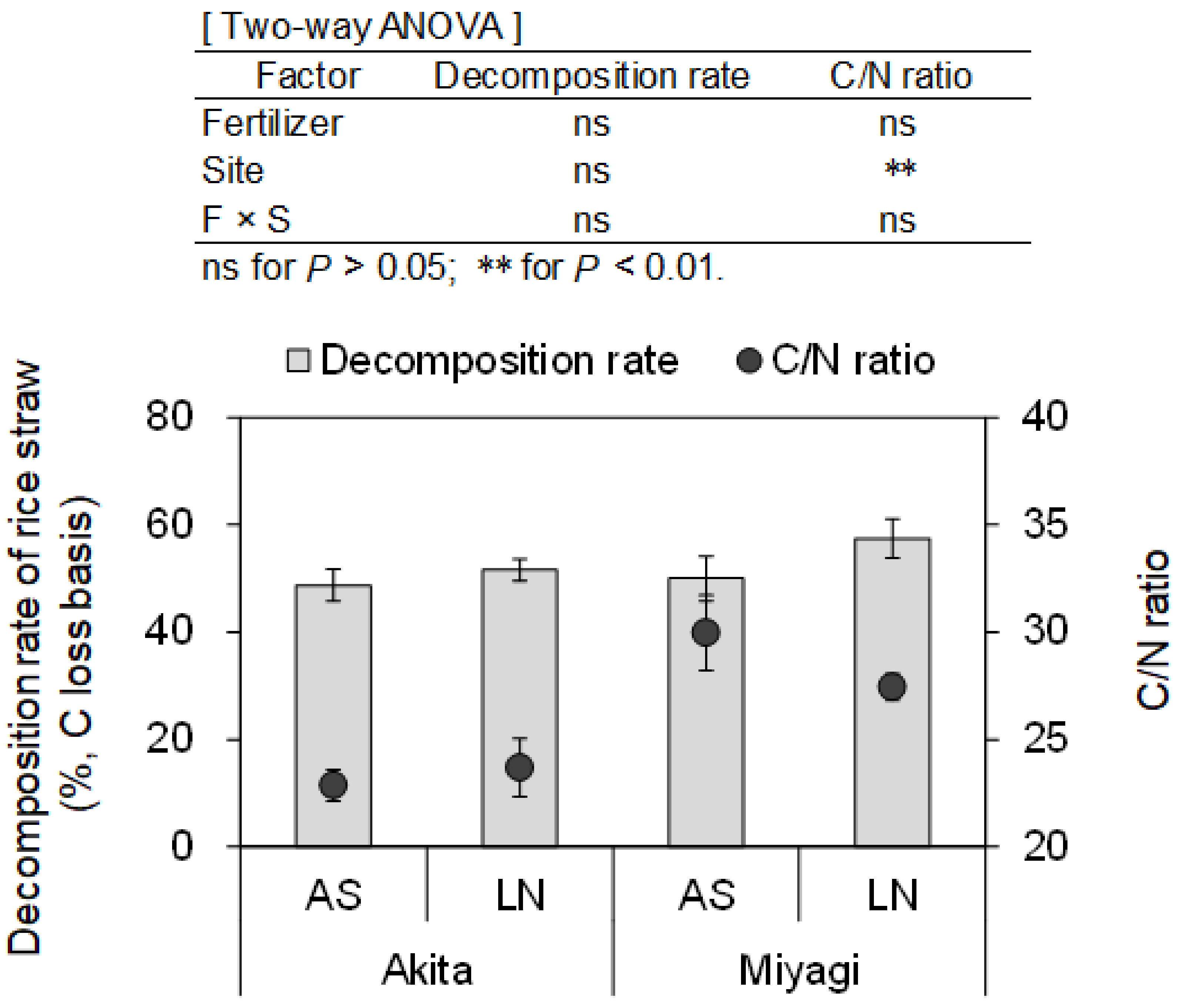
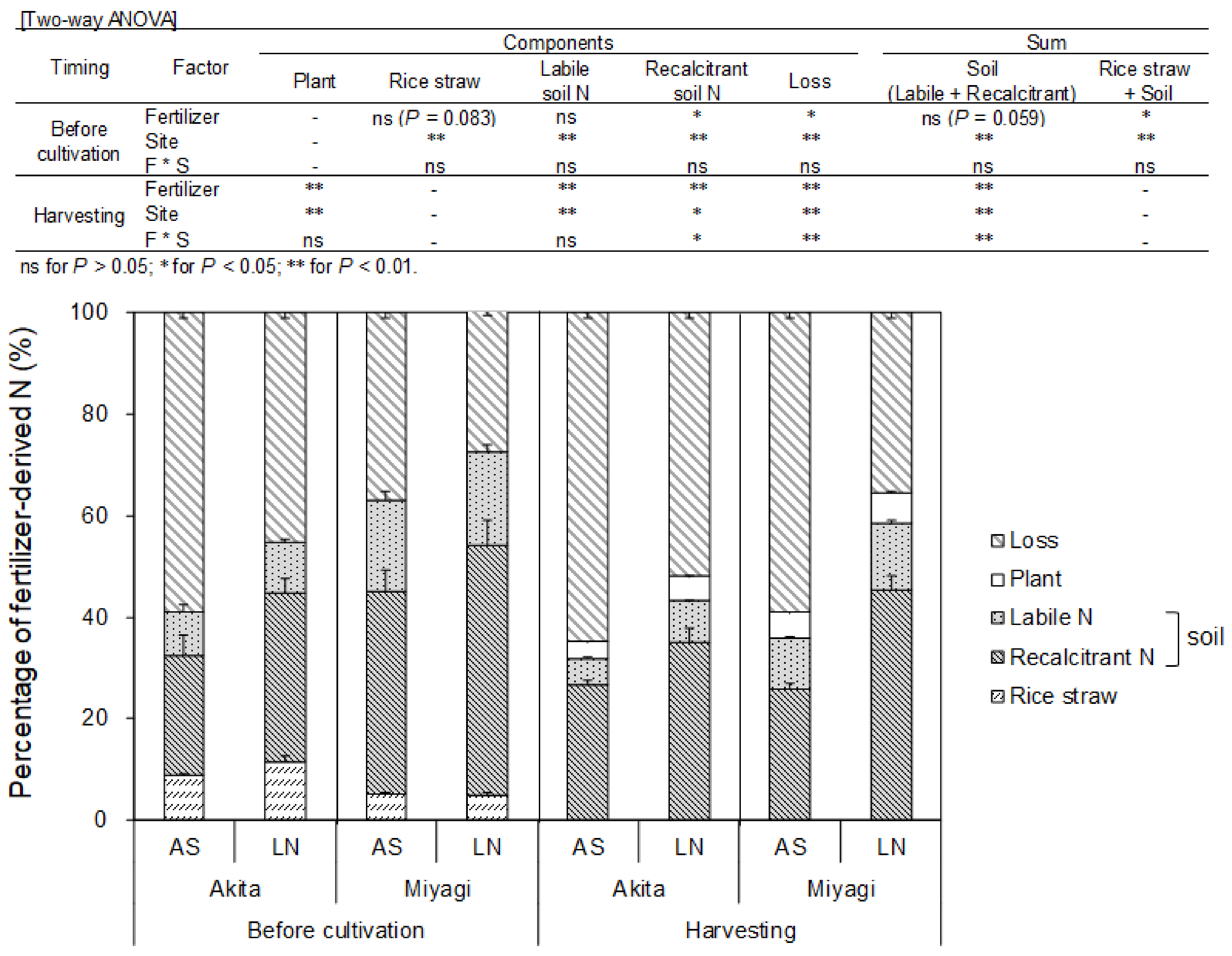
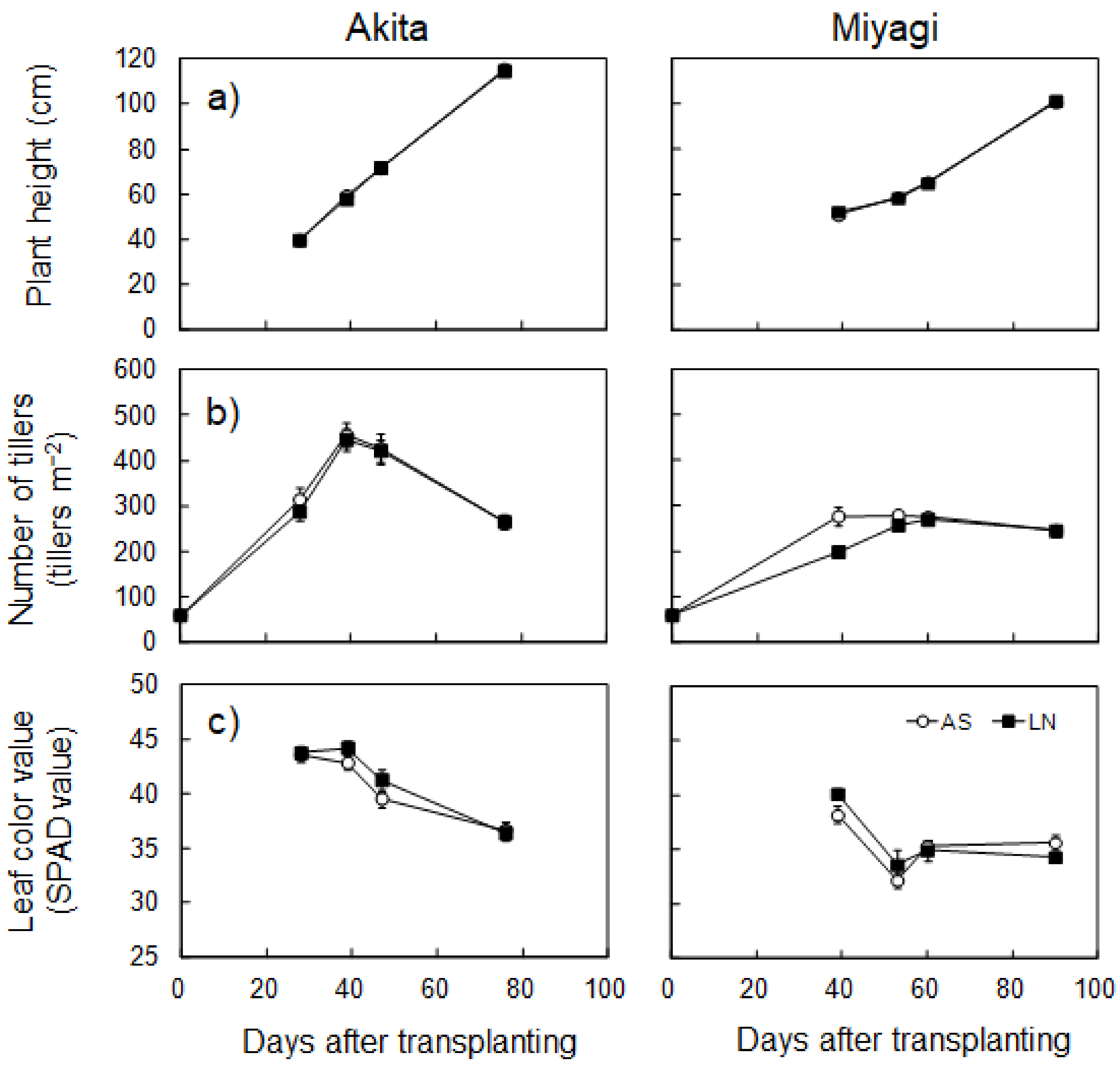
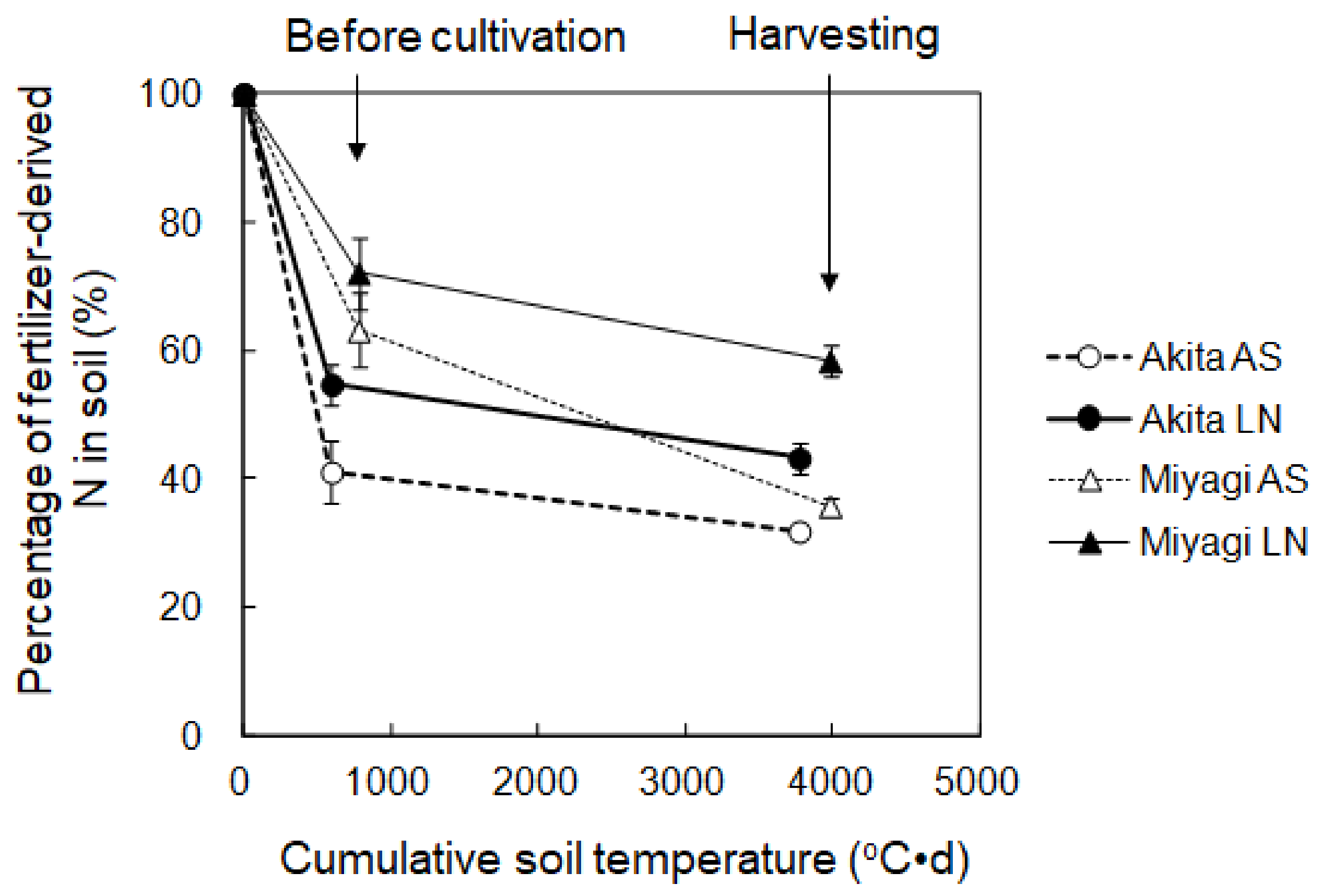
| Practice | Date | |
|---|---|---|
| Akita | Miyagi | |
| Soil collection | 30 September 2013 | 7 October 2013 |
| Frame install (fallow) | 17 October 2013 | 15 October 2013 |
| Frame collection and sampling(soil and rice straw, before cultivation) | 7 April 2014 | 5 April 2014 |
| Frame install (paddy) and transplanting | 28 May 2014 | 15 May 2014 |
| Plant growth investigation (tillering stage) | 25 June 2014 (28) | 23 June 2014 (39) |
| Plant growth investigation (maximum tiller number stage) | 6 July 2014 (39) | 7 July 2014 (53) |
| Plant growth investigation and sampling (plant, panicle initiation stage) | 14 July 2014 (47) | 14 July 2014 (60) |
| Mid-season drainage | - | Late June 2014 (one week) |
| Start of intermittent irrigation | End of July 2014 | End of June 2014 (after mid-season drainage) |
| Plant growth investigation(full heading stage) | 12 August 2014 (76) | 13 August 2014 (90) |
| Final drainage | Early September 2014 | End of August 2014 |
| Sampling (soil and plant, harvesting stage) | 15 September 2014 (110) | 12 September 2014 (120) |
| Site | Soil Type | pH | EC | Exchangeable Cations (cmolC kg−1) | CEC | Total-C | Total-N | C/N Ratio | Available N † | Available P ‡ | |||
|---|---|---|---|---|---|---|---|---|---|---|---|---|---|
| (H2O) | (mS cm−1) | K | Na | Ca | Mg | (cmolC kg−1) | (g kg−1) | (g kg−1) | (mg N kg−1) | (mg P2O5 kg−1) | |||
| Akita | Gray lowland soil | 5.75 | 0.07 | 0.27 | 0.24 | 10.8 | 3.00 | 17.4 | 26.7 | 2.37 | 11.3 | 162.0 | 359 |
| Miyagi | Gray lowland soil | 6.50 | 0.15 | 0.80 | 1.09 | 17.3 | 2.62 | 19.3 | 19.3 | 1.80 | 10.7 | 107.0 | 189 |
| Fertilizer | Panicle Initiation Stage | Harvesting Stage | ||
|---|---|---|---|---|
| Akita | Miyagi | Akita | Miyagi | |
| AS | 293 ± 27 | 385 ± 21 | 931 ± 54 | 858 ± 57 |
| LN | 289 ± 61 | 413 ± 31 | 960 ± 11 | 864 ± 12 |
| t-test † | ns | ns | ns | ns |
| Fertilizer | Total N Uptake (g N m−2) | |||||
| TP to PI(at PI) | PI to H(H–PI) | Total(at H) | ||||
| Akita | Miyagi | Akita | Miyagi | Akita | Miyagi | |
| AS | 4.78 ± 0.11 | 4.96 ± 0.16 | 3.48 ± 0.27 | 2.03 ± 0.24 | 8.26 ± 0.30 | 7.19 ± 0.38 |
| LN | 4.93 ± 0.31 | 4.97 ± 0.21 | 3.35 ± 0.40 | 1.61 ± 0.36 | 8.29 ± 0.25 | 6.53 ± 0.26 |
| t-test † | ns | ns | ns | ns | ns | ns |
| Fertilizer | Fertilizer-Derived N Uptake (g N m−2) | |||||
| TP to PI(at PI) | PI to H(H–PI) | Total(at H) | ||||
| Akita | Miyagi | Akita | Miyagi | Akita | Miyagi | |
| AS | 0.09 ± 0.01 | 0.18 ± 0.01 | 0.05 ± 0.01 | 0.05 ± 0.01 | 0.15 ± 0.01 | 0.22 ± 0.01 |
| LN | 0.14 ± 0.01 | 0.20 ± 0.01 | 0.07 ± 0.01 | 0.06 ± 0.01 | 0.21 ± 0.01 | 0.27 ± 0.00 |
| t-test† | ** | ns | ns | ns | ** | ** |
© 2018 by the authors. Licensee MDPI, Basel, Switzerland. This article is an open access article distributed under the terms and conditions of the Creative Commons Attribution (CC BY) license (http://creativecommons.org/licenses/by/4.0/).
Share and Cite
Takakai, F.; Hirano, S.; Harakawa, Y.; Hatakeyama, K.; Yasuda, K.; Sato, T.; Kimura, K.; Kaneta, Y. Fate of Fertilizer-Derived N Applied to Enhance Rice Straw Decomposition in a Paddy Field during the Fallow Season under Cool Temperature Conditions. Agriculture 2018, 8, 50. https://doi.org/10.3390/agriculture8040050
Takakai F, Hirano S, Harakawa Y, Hatakeyama K, Yasuda K, Sato T, Kimura K, Kaneta Y. Fate of Fertilizer-Derived N Applied to Enhance Rice Straw Decomposition in a Paddy Field during the Fallow Season under Cool Temperature Conditions. Agriculture. 2018; 8(4):50. https://doi.org/10.3390/agriculture8040050
Chicago/Turabian StyleTakakai, Fumiaki, Seiya Hirano, Yuka Harakawa, Keiko Hatakeyama, Kentaro Yasuda, Takashi Sato, Kazuhiko Kimura, and Yoshihiro Kaneta. 2018. "Fate of Fertilizer-Derived N Applied to Enhance Rice Straw Decomposition in a Paddy Field during the Fallow Season under Cool Temperature Conditions" Agriculture 8, no. 4: 50. https://doi.org/10.3390/agriculture8040050





